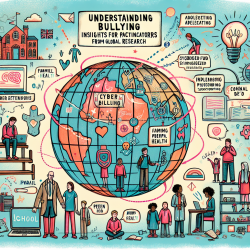Intimate partner violence (IPV) against women is a pervasive global public health issue, with significant implications for both the physical and mental health of women and their children. A recent study titled "Global, regional, and national prevalence estimates of physical or sexual, or both, intimate partner violence against women in 2018" provides comprehensive insights into the prevalence and patterns of IPV worldwide. For practitioners working with affected populations, understanding and implementing the findings of this research can significantly enhance their ability to support and advocate for their clients.
Key Findings of the Research
The study, conducted by Sardinha et al., revealed alarming statistics:
- Globally, 27% of ever-partnered women aged 15–49 years have experienced physical or sexual IPV in their lifetime.
- 13% of women in the same age group experienced IPV in the year preceding the survey.
- IPV starts early, with 24% of women aged 15–19 years having already experienced it.
- Regional variations exist, with higher prevalence in low-income countries.
Implications for Practitioners
Practitioners can leverage these findings to enhance their skills and interventions in several ways:
1. Awareness and Education
Understanding the prevalence and early onset of IPV can help practitioners develop targeted educational programs for schools and communities, focusing on prevention and early intervention.
2. Screening and Assessment
Incorporating routine screening for IPV in clinical settings can help identify victims early. Practitioners should be trained to use validated screening tools and create a safe environment for disclosure.
3. Multisectoral Collaboration
The study underscores the need for multisectoral interventions. Practitioners should collaborate with healthcare providers, social services, and law enforcement to provide comprehensive support to IPV victims.
4. Advocacy and Policy Development
Practitioners can advocate for policies that protect women from IPV and ensure access to necessary services. This includes pushing for laws that address the economic and social factors contributing to IPV.
Encouraging Further Research
While the study provides robust data, it also highlights the need for ongoing research, particularly in understanding the impact of interventions and the specific needs of different populations. Practitioners should:
- Engage in or support research initiatives that explore effective prevention and intervention strategies.
- Stay updated with the latest research to inform their practice.
- Participate in professional development opportunities related to IPV.
Conclusion
By integrating the findings of this comprehensive study into their practice, practitioners can enhance their ability to support victims of IPV effectively. Continued education, routine screening, multisectoral collaboration, and advocacy are crucial steps in addressing this pervasive issue.To read the original research paper, please follow this link:
Global, regional, and national prevalence estimates of physical or sexual, or both, intimate partner violence against women in 2018.










